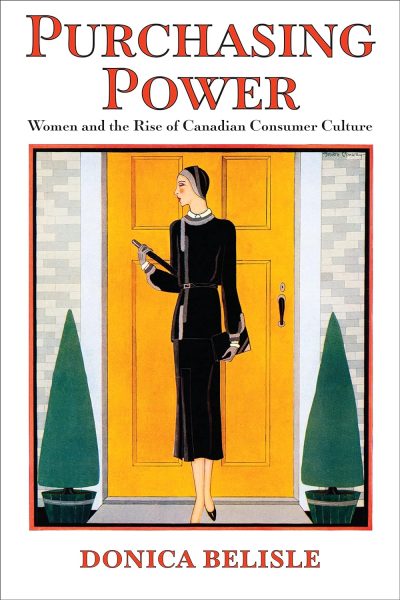
Purchasing Power: Women and the Rise of Canadian Consumer Culture
Review By Jacqueline Holler
December 22, 2023
BC Studies no. 219 Autumn 2023 | p. 134-136
In the past two decades, new global histories have dedicated increasing attention to the role of consumption as a driver of both economic and political changes such as industrialization and the rise of the nation-state. Donica Belisle’s Purchasing Power aligns with that global trend and complements earlier works on consumerism and gender in Canada by scholars like Joy Parr, Joan Sangster, and Magda Fahrni. Focussing on the period between the late nineteenth century and the beginning of the Second World War, Belisle argues that Canadian women, though largely absent from the formal workforce and political processes, constituted themselves as citizens through their central and increasingly important roles as consumers. Through consumption, Belisle claims, Canadian wives and mothers helped create the nation, its economy, and its identity.
The book’s argument is articulated in six chapters that proceed chronologically and thematically from the temperance movement in the later nineteenth century to women’s cooperative purchasing movements in the inter-war years. Intervening chapters assess women’s participation in food conservation during the First World War, contestations over fashion in the early twentieth century, Women’s Institutes and rural consumption, and the beginnings and institutionalization of home economics. The primary sources for these studies range from university calendars (for home economics) to reports of women’s institutes and the publications of women’s organizations such as the WCTU’s White Ribbon Tidings. The chapters deftly weave women’s consumption into issues of recognized national significance. For the most part, the results are insightful and significant, demonstrating both how both women and men came to see domestic consumption as key to the nation’s fortunes and, in the case of women, as a source of female pride and dignity. Occasionally, however, the primary sources are overinterpreted. For example, Belisle effectively demonstrates how the WCTU promoted a “mother-centred spending vision” (39) in its publications, asking its female readers to contemplate “how many beautiful luxuries can be purchased with the price of a case of liquor” (39). However, she then goes on to assert that the WCTU was actively seeking to promote consumerism (41). An equally or more plausible assertion would be that the WCTU saw the organizing possibilities inherent in the age-old tension over family spending in a time when women were less willing to tolerate autocratic male control over family finances.
Similarly, while class tensions are usefully analyzed (particularly in the chapter on wartime conservation), the analysis of race and ethnicity in the book seems strained. We learn, for example, that women’s movements were “predominantly white,” which is perhaps to be expected in a period when the population of Canada was more than 90% of European origin. Strikingly, however, there is little evidence of racial or ethnic animus in the primary sources cited. For example, Belisle reports on critiques of incompetent homemaking by promoters of home economics. She notes that while articles “did not single out non-British homemakers’ behaviour as deviant,” “it is likely that their criticism of improper shopping and cooking habits was influenced by their views of the non-white and non-Western European Other” (91). If the primary sources reveal limited evidence of the kinds of tension and hatreds found in other domains, Belisle explains this finding away through recourse to intention, missing the opportunity for a more interesting analysis—including, perhaps, progressive potentials of consumerism (as seen in American consumers’ “anti-sweatshop” campaigns of the early twentieth century).
In this case and throughout, the relative absence of evidence from British Columbia is disappointing. Given BC’s ethnic composition and racial tensions in the early twentieth century, further attention to the province might have illuminated the relationship between consumerism and heightened (or lessened) racial discrimination. Similarly, fruit producers in BC figure in the chapter on purchasing cooperatives, but the focus is on women purchasers on the prairies. We are told of only one instance in which the Vancouver-based BC Consumers’ League engaged in bulk fruit purchase (pp. 174–175). Further discussion of the League and its activities would have added a valuable BC perspective to the book, as would more inclusion of BC evidence throughout.
Regardless of these criticisms, Belisle’s book provides important insight into the role and self-fashioning of Canada’s women in the early twentieth century and contributes effectively to the broader history of consumption in the modern world. It will be a useful addition to syllabi in Canadian history, the history of consumption, and gender history.
Publication Information
Belisle, Donica. Purchasing Power: Women and the Rise of Canadian Consumer Culture. Toronto: University of Toronto Press. 2020. 304 pp. $34.95 paper.
